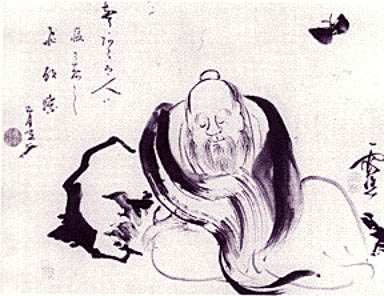Inception: Dreams, Waking, and Epistemology
This issue has been around for about as long as recorded history, and has formed a central piece of some very detailed philosophical considerations. It shows up in the 4th Century B.C.E. in the famous Taoist Zuangzi’s “butterfly dream”:

It also forms a central part of Indian philosophy, especially advaita vedanta, which explores cosmological questions through the exploration of the nature of the different states of consciousness that the human being is capable of. As the movie Inception points out, it is far more difficult to determine whether we are waking or dreaming than it may at first appear.
Of course Inception is a movie, and as such remains beholden more to plot development than fidelity to current dream studies. I commend Christopher Nolan (the director) for taking up this topic and developing it in ways that are terrifically engaging and not too ‘dumbed-down’. As the lengthy history of the topic implicitly indicates, understanding dreams and their relation to waking life is no easy task, so any popular treatment that gets people interested and questioning gets kudos from me. Personally, I get the biggest kick from movies which take up topics related to consciousness in ways that maintain a high degree of fidelity to esoteric principles, and which don’t abandon them for the sake of simplicity or storytelling for its own sake, or which at least achieve a healthy balance. Inception gets close to walking this line, but falls short in some key areas.
In regards to dreaming and waking, the most fascinating issue within the movie is epistemological: the question of how we know whether we are awake or dreaming. In the movie, a “totem” is utilized, which is a physical device that exhibits some particular behavior in accordance with the accepted (waking) laws of physics. Supposedly in a dream, the object will behave differently, thus signaling to the dreamer that he or she is dreaming. (For all of you who are familiar with lucid dreaming, I’ll get there later on, and am speaking now only about “regular” dreams.)
There are a few things to point out here. The first is that there is something very correct about the assumption underlying this technique, which we can sum up as: there is a certain quality to the way perceived objects behave in waking reality. This quality could quite appropriately be called “inertia”, which is to say that there is a certain quality of stubbornness in our perceiving. This inertia shows up most clearly in regards, specifically, to perceptions which rely on very simple and limited physical constraints. All the “totems” in Inception rely upon this: the way, for example, gravity interacts with a particular object, like a spinning top, a loaded dice, or a chess piece weighted off-center. The common utilization of the physical force of gravity provides a perfect metaphorical quality of this kind of consciousness: it is a consciousness that tends to “fall” into “facts” when perception happens.
In other words, day-waking consciousness is very Earthy; we meet with perceptions which have their own stubborn nature, despite our moods, our desires, or our intentions. The loaded dice will always statistically perform in the same manner over time; the spinning top will always eventually fall after about a certain length of time for a given initial spin rate.

This points to a quality of waking consciousness that is quite different from dreaming: it is chock-full of these sorts of “inertial facts of perception”. Indeed, the brain, in order to allow us to perceive, is built in such a way as to both rely upon these types of inertial facts, precisely so that it can keep them from becoming conscious. This allows the brain to free itself from the need to process everything as if for the first time; it makes BIG assumptions about what we perceive in order to get on with other processes. The key for waking consciousness is that if we decide to pay attention to a given fact, it exhibits a certain quality of stubbornness.
Inception did not (in my estimation) properly make this distinction: it showed the dream world as equally detailed as the waking world. But dreams simply don’t have the level of detail that is “stubbornly” available to waking consciousness. As anyone who can remember a dream can probably see for themselves, however, in a dream there is only as much detail as is… needed. In a dream there is generally only detail where our dream-attention is; the absence of detail elsewhere is ignored, and we don’t question whether or not such detail could be there if we directed our attention to check.

Of course this raises the question: “Couldn’t you just dream that you checked the details repeatedly and always found them consistent?” Apart from the unavoidable and fascinating deep philosophical nature of this maneuver, the practical answer is: not really. Why? Because the quality of the consciousness of the two types of checking (waking and dreaming) is different, and it is a quality that is experienced from within during the checking, not inferred after the fact on the basis of its “results”. In other words the results of the experience of checking is less important than the quality of consciousness in which the checking is carried out in the first place.
This is a very important point to get across: there is a difference between the content of dream consciousness and the quality of dream consciousness. This is equally true of waking consciousness: the content and quality can be distinguished. The question raised in the movie that was supposed to help a dreamer realize they were dreaming appropriately (but only implicitly) utilized this difference. The question was “How did I get here?” (wherever “here” is in the dream).
Now first of all this is not a question that is usually asked from within the dream, but only upon waking, by consulting our memory of the dream. As Inception rightly points out, we generally never can trace a dream to a “beginning”: they always seem to start “in the middle”. I put those phrases in quotes because the determination of what makes a beginning or a middle is not so much a specific content of consciousness, but rather the quality of our consciousness. We have to “feel it out”; it isn’t presented as a stark, undeniable “fact”.
In waking reality we can trace our day backward, and if we get good at it, we can do so without encountering any “gaps” that defy explanation. Indeed, this practice may be one of the most fundamental for developing one’s spiritual capacities; in the discipline of anthroposophy this exercise is known as the ‘daily review’, and is best practiced at the end of the day right before sleep. Ideally one traces one’s day all the way back into the previous mornings dreams, and through the dreams to the silent and mysteriously full space of one’s consciousness as it was just before it started dreaming.
Now interestingly enough, practicing the daily review can quite definitely lead to the experience of being conscious that one is dreaming. When we awaken within a dream we notice a fundamental qualitative shift to a mode that is almost indistinguishable from the qualities of waking consciousness. I was happy to note that Inception included a common feature of this transition to the lucid dream: dream characters may all suddenly turn and look at the dreamer. As projections of the dreamer’s own subconscious, this is a literal expression of the quality of becoming awake to oneself in the dream. In this moment a loop is closed, forming a recursive cycle: the dreamer is aware that the dream characters are dream characters, i.e. parts of the dreamer; thus the dream characters place their attention on the dreamer because the dreamer is placing her attention on herself; the subconscious projections of the dreamer follow and embody the qualitative shift in consciousness.
The possibilities of lucid dreaming were not well explored in Inception. The main character, wonderfully played by Leonardo DiCaprio, was put in a strange situation where he knew he was dreaming, and knew that his subconscious was generating dream elements against his will, but was unable to respond in the way open to most lucid dreamers: conscious control. In the movie Leonardo had to psychologically deal with the subconscious projections in a sort of “working through” that can be circumvented by lucid dreamers, because the prime quality of lucid dreaming (apart from the simple fact of being awake in the dream) is that the dreamer can consciously manipulate the dream world. This brings me to a discussion of the types of dreams and their nature.

For example, the “lowest” level of dreaming is often completely symbol-less. This type of dream is often known as a “night terror”, and occurs most often in children. Significantly, it is very common for there to be no recollection of any dream content whatsoever; the dreamer simply awakens in a state of panic, often with disorientation. Sometimes feelings of falling or emptiness or almost existential dread are reported, but not “normal” types of dream sequences that might account for the terror, such as being chased by an unknown figure. These dreams are essentially time-less and space-less, and generally aren’t experienced from within as having either of these qualities.
A step up from this lowest level of dreaming is the “normal” dream that we are all familiar with. These dreams are full of content, often have “plots” which can be written down with some coherence upon waking, and which contain one or many symbols of various types. In normal dreams we are not aware that we are dreaming, and we usually experience the dream from within qualitatively “in the present”, without consciousness of either past or future. However, these dreams unfold in both time and space.
Next is the lucid dream, which, as discussed, involves awakeness of the dreamer to the fact of dreaming while in the dream. Such dreams are often far more vivid than a normal dream. Indeed, the qualitative difference between a normal dream and a lucid dream is essentially the same as between a normal dream and being awake normally, and if we look at the brain activity of a lucid dreamer it is almost impossible to distinguish from waking. In a lucid dream, it is often possible for the dreamer to control the dream to a greater or lesser extent.
Are there any dream states “above” that of the lucid dream? Yes. We can call these “significant dreams”. Significant dreams are as qualitatively different from lucid dreams as lucid dreams are from normal dreams. Unfortunately, while it is possible to train to become a lucid dreamer, it is not possible to control the appearance of a significant dream. Why? The short answer is that this is not possible because significant dreams are literally beyond the individual dreamer, and arise as a consequence of a connection from the spiritual world to the dreamer, essentially as a “gift”. Significant dreams are very uncommon; we may have one or two or none in our whole life. But if we do have a significant dream, they may change our lives, often in subtle or long-term ways. The key characteristic of a significant dream is that it actually feels like it is a gift from our higher selves.







I agree, Inception fails to explore in depth the levels you mention however it would be quite difficult to do so in 2 hours. Hollywood is a business first so the theatrical aspect takes priority. I doubt that if the movie would do that it would be everyone’s cuppa.
On another note however I believe that is better than Matrix in many ways. The trilogy focused more on ‘the one’ idea and less on the technicalities of a lucid dream. In this sense Inception represents progress :-) and I must say I was surprised to see it having so much success
Kind regards,
Costin
Hi, really interesting reading your blog post. It’s one of my favourite movies, I find dreams so fascinating! A little confused about your “significant dreams” discussion – I have never heard of this level of dreaming before. Are you saying that it is some spiritual connection to something? What about individuals who do not hold belief in the spiritual side of things? Please explain, I’m intrigued!
Hi, I’m not sure where you got your ideas about details in lucid dreams, but the experiences of many people as well as considerable research shows quite contrary results.
For example, Stephen LaBerge **insisted** years ago that it was impossible to read clearly in a dream. I remember reading this in the mid 80s, and a few nights later, I found myself reading that exact page in a dream. I checked and sure enough, I kept reading for several pages, looked away, looked back, the words were very stable and quite easily readable. I’ve had many “false awakenings” (that later turned out to be dreams) in which I assiduously checked very tiny details throughout my environment, sometimes for 5 minutes or longer. The details were extremely precise, stable, with plenty of “inertial” stability.
Apart from my own personal experience, there are testimonies from yogic dreamers from past and current centuries describing very precise experiences with stable details. And finally, there is considerably research showing this as well. Alan Worsley was a master lucid dreamer whose dreams were recorded over a number of years by British researcher Keith Hearne. Worsley was able to determine precisely what was going to happen with complete control. For example, in one dream he had in the lab, which was recorded as lasting over an hour, he experimented with changing the TV channels by conscious intention and literally creating the TV show.
If what you meant – (perhaps I misunderstood) – was that the kind of lack of detail and instability you describe is true of 99% of people, then I would agree. You seem to have made categorical statements that such detailed dreams can NEVER happen – if that’s what you meant, then personal experience as well as scientific research contradicts you
In any case, this is a very nice site and I don’t mean to be overly critical (though that might help in generating lucid dreams:>)) I just wanted to correct a possible misunderstanding for others who drop by.